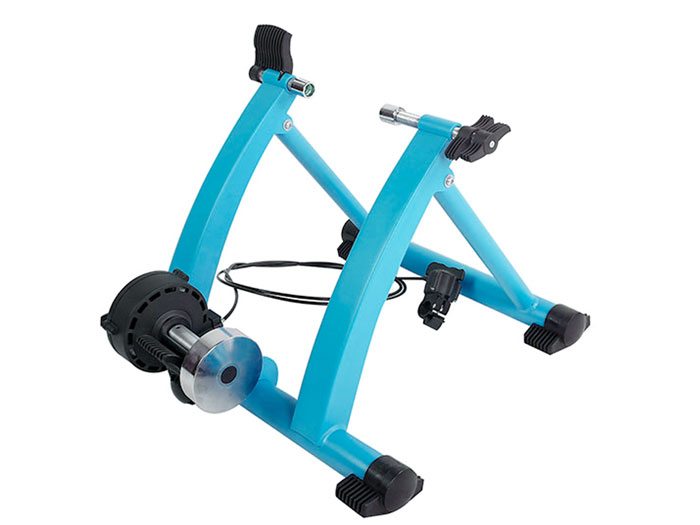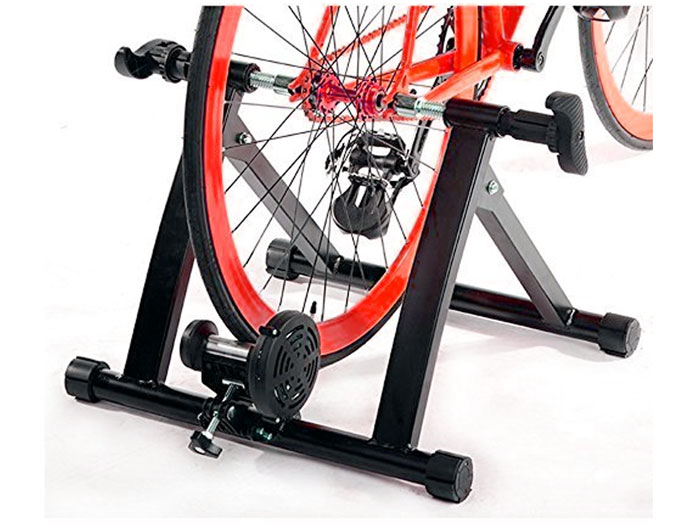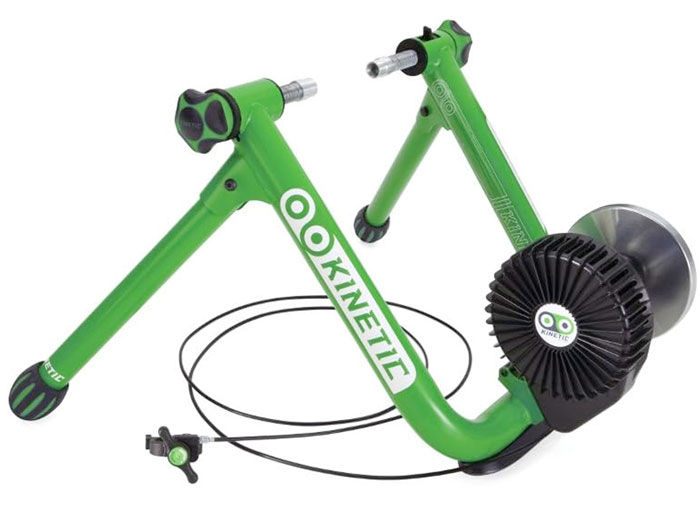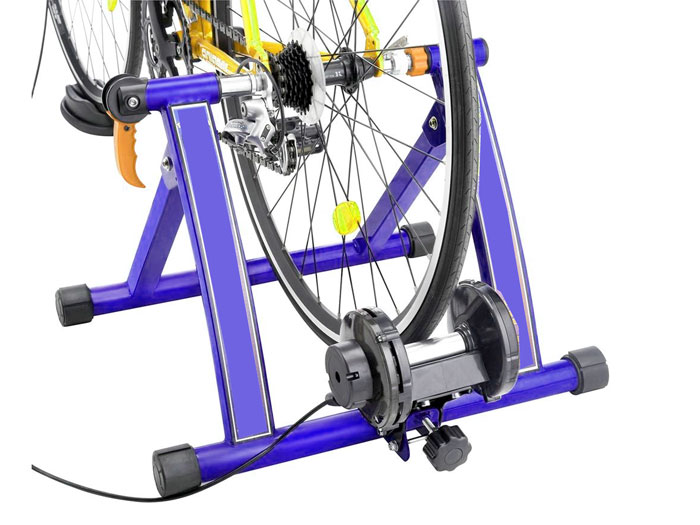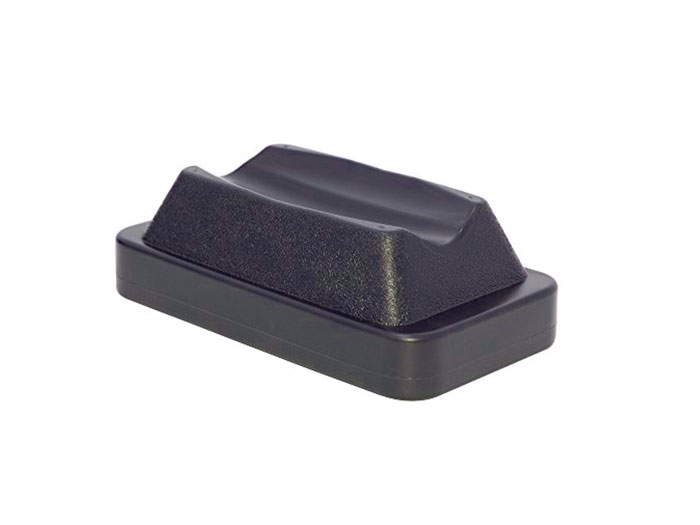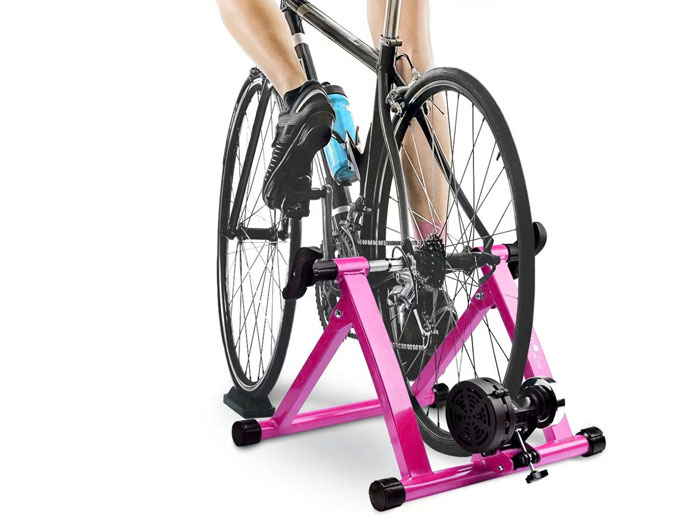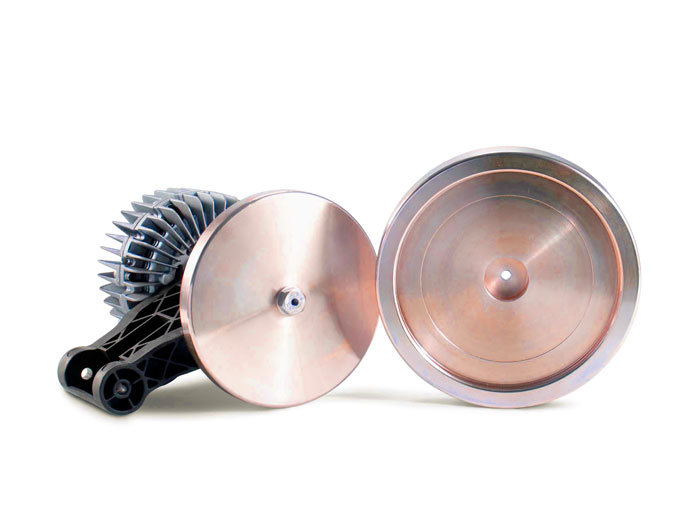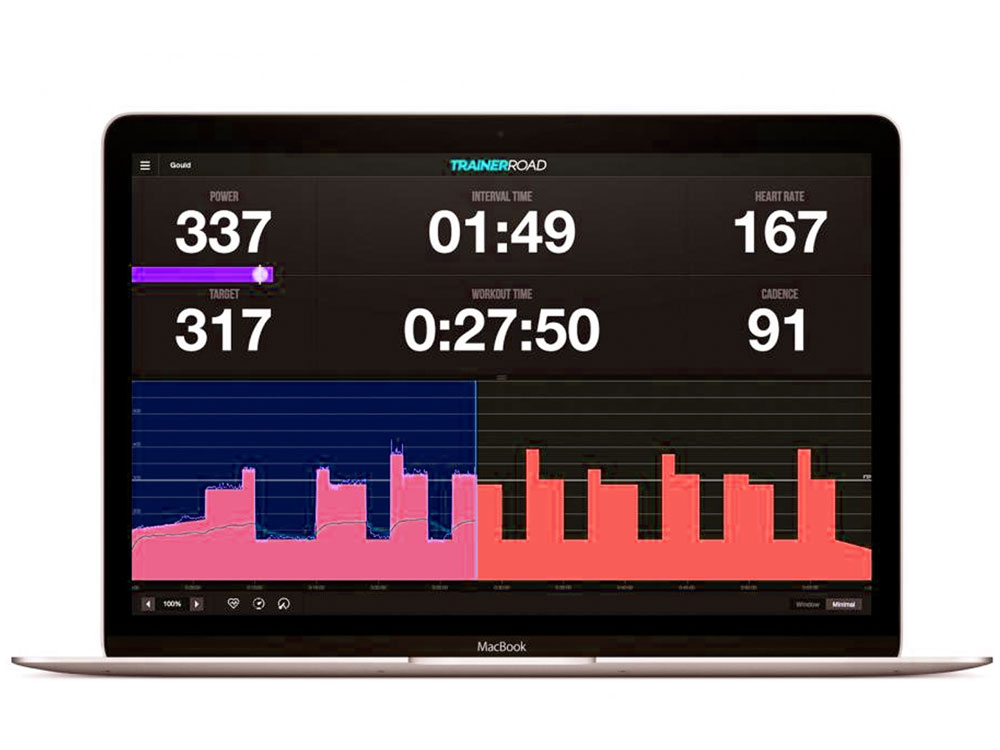Magnetic Trainer aka ‘MAG’ Trainer
Magnetic Trainers are exercise bikes that operate with magnetic resistance.
How do they function?
Well, the magnets work their magic to create resistance and add some pressure to the flywheel.
With magnetic resistance, the bike’s internal magnets can be adjusted to either get closer or move away from the flywheel.
When they’re closer, the resistance increases, making your pedaling more challenging. On the flip side, moving the magnets farther away reduces the resistance, giving you a smoother and easier ride.
One of the major advantages of magnetic resistance is its smooth and quiet operation. Since there’s no physical contact between the magnets and the flywheel, you can enjoy a noise-free workout.
Not only that, but this type of resistance also tends to be low-maintenance, as there’s no friction to cause wear and tear.
The beauty of magnetic resistance is its versatility. Whether you’re a beginner, an intermediate rider, or a fitness enthusiast, these bikes offer a wide range of resistance levels to cater to your fitness goals. Many models come with convenient control knobs or digital interfaces, allowing you to effortlessly adjust the resistance according to your preferences.
There are also the more sophisticated electromagnetic bike trainers which are much more advanced but also come with a much more expensive price tag. (see our guide to electromagnetic resistance bike trainers.)
What Is Magnetic Resistance?
A Quick Lesson
Magnetic resistance in a bike trainer works by utilizing magnets to create a resistance force that opposes the rotation of the bike’s flywheel.
The trainer typically consists of a flywheel, which is connected to the rear wheel of the bike, and a magnetic resistance unit.
Inside the resistance unit, there are magnets that can be adjusted to vary the distance between them and the flywheel. By changing this distance, the magnetic field strength changes, which in turn alters the amount of resistance applied to the flywheel.
When you pedal on the bike, the flywheel rotates, and the magnetic resistance creates a force that resists the rotation, making it harder to pedal.
By adjusting the position of the magnets, you can increase or decrease the resistance level to make your workout more challenging or easier.
One advantage of magnetic resistance is its ability to provide a smooth and consistent resistance without direct contact between the resistance unit and the flywheel, reducing wear and tear on the components.
Additionally, magnetic trainers often offer adjustable resistance levels, allowing you to customize your workout intensity.
Quick Overview of Pros & Cons of the Magnetic Trainer
| PROS Of The Magnetic Trainer | CONS Of The Magnetic Trainer |
|---|---|
|
Lack of interactive features for immersive training experiences Fixed resistance levels that may not cater to individual training needs Less realistic road-like feel compared to fluid trainers Potential wear and tear on tires due to direct contact with the rolleMay require additional accessories for stability and leveling Limited resistance options compared to more advanced trainers Less accurate power measurement and data tracking capabilities |
The Case FOR a Magnetic Bike Trainer (Pros)
A standard magnetic bike trainer offers simplicity, affordability, and adjustable resistance, making it a popular choice for cyclists looking to bring their rides indoors. Whether you’re a beginner or an experienced rider, a magnetic trainer provides a convenient and effective way to maintain your cycling fitness at home.
If you are looking for more advanced features you may want to consider an electromagnetic resistance bike trainer.
Adjustable Resistance:
Magnetic trainers provide adjustable resistance levels, allowing you to customize your workout intensity. By simply turning a control knob, you can increase or decrease the resistance to match your fitness goals and desired challenge.
Quiet Operation:
Magnetic trainers operate quietly compared to other types of trainers. The magnetic resistance mechanism doesn’t involve any physical contact, resulting in a smooth and quiet riding experience. This makes it ideal for home use, ensuring that you can cycle without disturbing others around you.
Cost-Effective:
Regular magnetic trainers are often more affordable compared to other advanced trainer options. If you’re on a budget or just starting with indoor cycling, a magnetic trainer offers a cost-effective solution without compromising on performance.
Ease of Use:
Magnetic trainers are user-friendly and easy to set up. You can quickly attach your bike to the trainer, adjust the resistance, and start pedaling. They usually have a simple design with fewer moving parts, making them straightforward to operate and maintain.
Durability:
Magnetic trainers are known for their durability and long-lasting performance. With a sturdy frame and reliable magnetic resistance system, these trainers can withstand regular use and provide consistent performance over time.
Portability:
Many regular magnetic trainers are lightweight and compact, making them easy to transport and store. They often feature a foldable design, allowing you to conveniently set up or pack away the trainer when needed.
Wide Compatibility:
Magnetic trainers are generally compatible with a wide range of bikes, including road bikes and mountain bikes. They usually offer adjustable clamping systems or quick-release skewers to securely hold your bike in place.
The Case AGAINST a Magnetic Bike Trainer (Cons)
While standard magnetic trainers offer several benefits, there are also some drawbacks to consider:
Limited Resistance Options:
Regular magnetic trainers typically have a limited number of resistance levels. This can be a drawback for advanced or experienced riders who require more precise control over their training intensity.
Less Accurate Power Measurement and Data Tracking:
Unlike smart trainers, regular magnetic trainers may not provide accurate power measurement or advanced data tracking features. This can be a limitation for riders who want to closely monitor their performance and progress.
Lack of Interactive Features:
Regular magnetic trainers lack interactive features found in smart trainers, such as virtual riding simulations, interactive training programs, and app connectivity. These features can enhance the training experience and make indoor riding more engaging.
Fixed Resistance Levels:
Unlike fluid trainers, regular magnetic trainers have fixed resistance levels that cannot be automatically adjusted based on external factors like gradient changes or virtual courses. This can limit the versatility and realism of your indoor training sessions.
Less Realistic Road-like Feel:
While magnetic trainers provide resistance, the feel of riding on them may not accurately replicate the experience of riding on the road. The resistance can feel less smooth and linear compared to fluid trainers, affecting the overall riding experience.
Wear and Tear on Tyres:
Regular magnetic trainers require direct contact between the tire and the roller, which can lead to increased wear and tear on your bike’s tire over time. This may necessitate more frequent tire replacements or the use of specific trainer tires.
Additional Stability and Leveling Requirements:
Some regular magnetic trainers may require additional accessories, such as a front wheel riser block, to provide stability and ensure that your bike is properly leveled during training.
While regular magnetic trainers can still be a suitable option for many cyclists, these cons should be taken into account when considering your specific training needs and preferences.
Buying Guide for Magnetic Trainers
What You Should Consider Before Buying
Are you in the market for a magnetic trainer to enhance your indoor cycling workouts?
You’re in luck!
Our comprehensive Buying Considerations Guide for magnetic bike trainers is here to assist you in making a well-informed choice.
We’ll guide you through the essential factors to consider, ensuring you have all the information you need.
With our expert tips and insights, you’ll be fully equipped to select the ideal magnetic trainer that aligns with your training objectives and personal preferences.
Prepare to take your indoor cycling experience to new heights and reach your fitness milestones. Let’s dive in and get started!
Is Your Magnetic Trainer Compatible With Your Bike Wheel?
When considering a fluid trainer for your bike, it’s essential to ensure compatibility between the trainer and your bike’s wheel. Here are some key points to keep in mind:
Wheel Size:
Magnetic trainers are designed to be compatible with various wheel sizes commonly found in road bikes, mountain bikes, and standard bicycles.
They offer flexibility and can accommodate different wheel diameters, such as 26-inch, 27-inch, and 700c wheels.
It’s always a good idea to check the specific compatibility of the trainer with your bike’s wheel size before making a purchase.
Rear Dropout Spacing:
The rear dropout spacing refers to the distance between the rear wheel dropouts on your bike’s frame.
Magnetic trainers typically have adjustable rear dropout spacings, allowing them to accommodate different widths commonly found in road bikes, mountain bikes, and other bicycle types.
The standard rear dropout spacing for road bikes is 130mm, while mountain bikes often have wider spacings, such as 135mm or even 142mm for thru-axle systems.
Most magnetic trainers provide easy-to-use mechanisms to adjust the rear dropout spacing, ensuring a secure and stable fit for your bike.
However, it’s important to verify the specific compatibility of the trainer with your bike’s dropout spacing before purchasing.
Thru-Axle or Skewer:
Pay attention to the type of axle system your bike uses.
When it comes to magnetic trainers, compatibility with both thru-axle and quick-release skewer systems depends on the specific model.
Some trainers offer interchangeable adapters or thru-axle compatibility kits that allow you to use the trainer with bikes equipped with thru-axle systems.
On the other hand, many trainers come with a standard quick-release skewer that can be easily installed in the rear dropout.
Some bikes with unique specifications, such as thru-axles or non-standard dropouts, may need specialized adapters to properly attach to the magnetic trainer.
It’s essential to check the product specifications or consult the manufacturer to ensure the trainer supports your bike’s axle type, whether it’s thru-axle or quick-release skewer.
Additional Adapters:
In most cases, magnetic trainers come with a standard setup that fits various types of bikes. However, it’s crucial to check if your specific bike requires any additional adapters for compatibility.
By ensuring you have the necessary adapters, you can seamlessly connect your bike to the magnetic trainer and enjoy a smooth and secure riding experience.
Will You Use A Riser Block?
A riser block is a handy accessory that elevates the front wheel of your bike, creating a level riding position when using a trainer.
While it’s not always necessary, many cyclists find it beneficial for a more comfortable and realistic riding experience.
Using a riser block helps to align your bike in a proper position, preventing any downward tilt that may occur when the rear wheel is raised on the trainer. This helps maintain a natural riding posture and reduces strain on your body.
Whether you need a riser block depends on personal preference and the specific design of your magnetic trainer.
Some trainers come with integrated leveling mechanisms, eliminating the need for a separate riser block.
Consider factors like your bike’s geometry, your comfort level, and the type of trainer you’re using to determine if a riser block is necessary for your setup.
It’s always a good idea to consult the trainer manufacturer’s recommendations or seek advice from experienced cyclists for guidance.
How Big Is It?
Magnetic trainers are generally known for their compact design. They’re not overly bulky or cumbersome, making them a great option for those with limited space.
Most magnetic trainers are designed to be space-efficient, measuring around 30 inches or less in length and width. This means they won’t take up too much room in your home or apartment.
Plus, many models come with foldable frames that can be easily collapsed and stored away when not in use. Talk about convenience!
The compact size and foldable frames of magnetic trainers make them a breeze to store. Whether you have a dedicated workout area or need to tuck the trainer away after each use, you’ll find it easy to find a spot for it.
However, it’s important to note that the size and storage features can vary depending on the specific model and brand. Some trainers may have additional features or attachments that could affect their overall size. So, be sure to check the product specifications and dimensions before making a purchase.
Are the Resistance Levels Adjustable?
Yes!
Magnetic trainers use magnets to create resistance, providing a challenging workout experience. The resistance level can typically be adjusted to meet your fitness goals and training needs.
One of the advantages of magnetic trainers is their ability to offer a wide range of resistance levels.
Most models come with adjustable resistance settings that allow you to increase or decrease the intensity of your workout. This flexibility enables you to customize your training sessions and progress at your own pace.
The resistance on a magnetic trainer is controlled by the position of a magnet in relation to the flywheel.
By adjusting the magnet’s proximity to the flywheel, you can increase or decrease the resistance.
Some trainers have a control knob or lever that allows for easy adjustment, while others may offer electronic controls for more precise resistance changes.
Another notable feature of magnetic trainers is their smooth and consistent resistance.
The magnet and flywheel interaction creates a steady and reliable resistance, ensuring a consistent workout experience. This is especially important for those who want a realistic and engaging cycling experience indoors.
It’s worth mentioning that the maximum resistance level on a magnetic trainer may vary depending on the specific model. Some trainers are designed for high-intensity workouts and offer higher resistance levels, while others may be better suited for moderate-intensity training.
Strength & Stability of the Frame
Let’s look at frame strength and stability.
When it comes to the strength and durability of a magnetic trainer, you’ll find that they are generally well-built and designed to withstand regular use.
The frames of magnetic trainers are often made of sturdy materials like steel or aluminum, providing a solid foundation for your workouts. These materials offer excellent durability and ensure that the trainer can handle high-intensity pedaling without compromising stability.
Stability is a crucial factor when it comes to mag trainers. You want a trainer that stays firmly in place and doesn’t wobble or shift while you’re pedaling away.
Thankfully, most mag trainers are designed with stability in mind.
These trainers often feature wide bases that provide a solid foundation and help distribute your weight evenly. Some models even have adjustable leveling feet, allowing you to fine-tune the stability on uneven surfaces.
Additionally, the weight of the trainer itself contributes to its stability. A heavier trainer tends to be more stable as it has a lower chance of tipping or sliding during intense workouts.
However, it’s essential to strike a balance between weight and portability, especially if you plan on moving your trainer around frequently.
To ensure optimal stability, place your mag trainer on a level surface and double-check that it’s securely set up.
Some trainers also come with floor mats that can help prevent slippage and further enhance stability.
Overall, with a well-designed mag trainer and proper setup, you can expect a stable and reliable platform for your indoor cycling sessions.
How Do You Secure Your Bike to the Magnetic Trainer?
Securing your bike properly to the magnetic trainer is essential for a safe and effective workout.
So, how do you secure your bicycle to the stationary stand?
Most magnetic trainers utilize a quick-release mechanism or a threaded knob system to secure your bike in place.
Here’s how to do it:
- Quick-Release System: If your magnetic trainer uses a quick-release system, follow these steps:
- Open the quick-release lever on the trainer’s clamp mechanism.
- Remove the rear wheel skewer from your bike and replace it with the provided quick-release skewer that comes with the trainer.
- Place your bike’s rear dropouts onto the trainer’s clamp, making sure they are aligned and seated properly.
- Close the quick-release lever and ensure it is securely tightened to hold your bike in place.
- Threaded Knob System: For trainers that utilize threaded knobs, follow these steps:
- Loosen the threaded knobs on both sides of the trainer to create enough space for your bike’s rear wheel.
- Carefully position your bike’s rear wheel between the knobs, ensuring that the dropouts fit into the slots provided.
- Begin tightening the knobs alternately on both sides until they are securely tightened against the dropouts.
When securing your bike to the trainer, make sure to position it properly.
Align the rear wheel with the roller on the trainer, ensuring that the tire is centered and making good contact.
Tighten the clamping mechanism or threaded knobs firmly but not excessively, ensuring a secure grip without damaging your bike or the trainer.
Once your bike is properly secured, give it a gentle shake to ensure it is stable and firmly attached to the magnetic trainer. Double-check that all the connections are tight and secure before starting your workout.
Can I Interchange the Flywheel?
Some magnetic bike trainers offer the option of different flywheels.
The flywheel is a key component that helps simulate the feel of outdoor cycling and provides resistance during your indoor training sessions.
While most magnetic trainers come with a standard flywheel, there are certain models that allow you to customize or upgrade the flywheel based on your preferences.
The flywheel’s weight plays a role in determining the overall riding experience.
Heavier flywheels tend to provide a smoother and more realistic feel, as they store more momentum and replicate the inertia of outdoor riding.
Lighter flywheels may offer a quicker response to changes in pedaling speed, which can be desirable for certain training scenarios.
If you’re looking for a specific type of riding experience or have specific training goals in mind, it’s worth considering a magnetic trainer that offers interchangeable flywheels. This gives you the flexibility to choose a flywheel weight that suits your preferences and training needs.
Keep in mind that not all magnetic trainers provide the option to swap out flywheels. It’s important to check the product specifications or contact the manufacturer to determine if the trainer you’re interested in offers this feature.
By having the ability to choose different flywheels, you can customize your magnetic trainer to better align with your riding style and training goals, enhancing your overall indoor cycling experience.
What is a Roller?
A magnetic trainer typically includes a roller as part of its design.
What is the Roller?
The roller is the component that makes contact with your bike’s rear wheel while you’re cycling on the trainer.
It is usually positioned in line with the flywheel and is responsible for transferring the resistance generated by the magnetic system to your bike’s wheel.
The roller is typically made of a durable material, such as aluminum, and is designed to have a smooth surface. This helps reduce friction and wear on your bike’s tire, ensuring a smoother and more consistent riding experience.
The role of the roller is to provide a stable and secure contact point between your bike and the trainer, allowing for effective power transfer and resistance.
As you pedal, the rear wheel rotates against the roller, creating the necessary friction to generate resistance based on the magnetic system’s settings.
It’s important to note that different trainers may have variations in roller design and materials used. However, the primary function of the roller remains the same across magnetic trainers, ensuring a reliable connection between your bike and the trainer’s resistance mechanism.
How Noisy Is the Mag Bike Trainer?
When it comes to noise, magnetic trainers are generally known for being pretty quiet.
The resistance mechanism of a magnetic trainer doesn’t involve any physical contact or friction between parts, which helps keep the noise levels down.
That being said, the actual noise level can vary depending on factors such as the quality of the trainer, the materials used, and even the type of bike you’re using. Some trainers are designed with noise reduction features like rubberized components or precision engineering to minimize any potential noise.
That being said, it’s worth noting that there may still be some noise generated by the moving parts of your bike itself, such as the chain and gears. This is something you can’t entirely eliminate since it’s inherent to the bike’s mechanics.
To keep the noise level as low as possible, it’s a good idea to ensure your bike is well-maintained and properly lubricated. This can help reduce any unnecessary friction and noise while riding on the magnetic trainer.
Overall, magnetic trainers offer a relatively quiet indoor cycling experience, allowing you to enjoy your workout without disturbing the peace.
Maintaining A Magnet Bike Trainer
Maintaining a magnetic bike trainer is relatively simple and requires some basic upkeep to ensure its optimal performance. Here are a few tips to keep your trainer in good shape:
- Keep it clean: Regularly wipe down the surfaces of the trainer, including the frame, flywheel, and resistance unit, to remove any dirt, dust, or sweat. Use a damp cloth or mild cleaning solution as needed, but avoid harsh chemicals that could damage the components.
- Check for loose parts: Periodically inspect the trainer for any loose bolts, screws, or other components. Tighten them if necessary to prevent any wobbling or instability during your workouts.
- Lubricate moving parts: Apply a small amount of lubricant to the moving parts of the trainer, such as the resistance unit pivot points or any adjustable knobs. This helps ensure smooth operation and prevents any squeaking or sticking.
- Inspect the cables: If your magnetic trainer has cables for adjusting resistance, check them for any signs of wear or damage. Replace any frayed or damaged cables to maintain accurate resistance control.
- Store it properly: When you’re not using the trainer, store it in a clean and dry area to prevent dust accumulation and potential rusting. If your trainer is foldable, make sure to fold and secure it according to the manufacturer’s instructions to save space and maintain its shape.
What is Slippage & How Do I Prevent It?
What is Slippage?
Slippage refers to the unintended movement or slipping of the bike’s rear wheel on the trainer’s roller during indoor cycling workouts.
It occurs when there is inadequate grip or traction between the roller and the tire, leading to a loss of control and stability.
Slippage can result in an inconsistent pedaling experience, reduced resistance, and potential safety hazards.
It is important to address slippage issues to ensure a smooth and effective training session.
Slippage can be a common concern when using a magnetic bike trainer, especially if the bike is not securely attached. Here are some tips to minimize slippage:
- Properly secure the bike: Ensure that your bike is securely fastened to the trainer using the appropriate method, whether it’s a quick-release skewer, thru-axle adapter, or other compatible attachment mechanism. Double-check that the bike is tightly clamped in place to prevent any movement during your workouts.
- Check tire pressure: Maintaining the correct tire pressure is important for traction and minimizing slippage. Make sure your bike’s tires are inflated to the recommended pressure specified by the manufacturer. Insufficient tire pressure can lead to decreased grip on the trainer, resulting in slippage.
- Clean the roller and tyre: Over time, dust, sweat, and debris can accumulate on the roller and tire surface, reducing traction and increasing the likelihood of slippage. Regularly clean the roller and tire using a damp cloth to remove any buildup and ensure better contact between the two surfaces.
- Use a trainer-specific tyre: Consider using a trainer-specific tire designed to provide optimal grip and reduce slippage. These tires are made of a harder compound that can better withstand the friction generated by the trainer. They are less prone to wear and slipping compared to regular road tires.
- Adjust the tension: Most magnetic trainers offer adjustable tension settings. If you experience slippage, try increasing the tension to create more resistance and improve traction. Experiment with different resistance levels to find the one that offers a balance between grip and challenge during your workouts.
By following these tips, you can minimize slippage and ensure a secure and stable riding experience on your magnetic bike trainer.
Magnetic Trainer Digital Enhancements – Apps & Accessories
Can a regular Magnetic Bike Trainer use apps and digital enhancements with it?
Yes.
Regular magnetic trainers can be compatible with various digital enhancements, apps, and accessories to enhance your indoor cycling experience.
While traditional magnetic trainers may not have built-in digital features, they can still be paired with external devices and accessories to provide a more interactive and data-driven workout.
Here are some common digital enhancements you can use with a regular magnetic trainer:
Cycling Apps
There are numerous cycling apps available that can track your ride data, provide workout programs, simulate outdoor routes, and offer virtual training experiences. These apps can be downloaded on your smartphone, tablet, or computer and connected to your trainer via Bluetooth or ANT+.
Speed and Cadence Sensors
These sensors can be attached to your bike to measure your speed and cadence during your training session. They provide real-time data that can be used by compatible apps or devices to track your performance and monitor your progress.
Heart Rate Monitors:
By wearing a heart rate monitor, you can track your heart rate and use it as a guide for your training intensity. Many trainers and apps can integrate with heart rate monitors to provide more accurate and personalized workout feedback.
Power Meters:
Power meters measure the actual power output of your pedaling and provide precise data on your cycling performance. Some trainers can be paired with external power meters, allowing you to track and analyze your power metrics for a more comprehensive training experience.
Virtual Training Platforms:
Certain platforms, such as Zwift or TrainerRoad, offer immersive virtual cycling experiences. These platforms combine interactive training programs, virtual worlds, and multiplayer capabilities to make your indoor rides more engaging and enjoyable.
While regular magnetic trainers may not have these digital features built-in, they can still be compatible with a range of apps, sensors, and accessories to enhance your training, track your progress, and make your workouts more interactive and entertaining.
What’s The Difference Between a Magnetic Trainer & An Electromagnetic Bike Trainer
The difference between a magnetic bike trainer and an electromagnetic bike trainer lies in how they generate resistance:
Magnetic Bike Trainer:
A magnetic bike trainer uses a system of magnets to create resistance.
These trainers have a metal flywheel and a magnetic unit with adjustable magnets.
As you pedal, the magnets create a magnetic field that interacts with the flywheel, generating resistance.
The resistance level can be adjusted by moving the magnets closer or farther away from the flywheel, usually through a manual control knob or lever.
Magnetic trainers offer a smooth and consistent resistance but may have limited adjustability compared to other types.
Electromagnetic Bike Trainer:
An electromagnetic bike trainer also utilizes magnets to create resistance but with a different mechanism.
Instead of manually adjusting the position of the magnets, electromagnetic trainers use an electronic control system to vary the magnetic field strength.
This adjustment can be done automatically or through a connected device.
By altering the electromagnetic field, the trainer can provide precise and programmable resistance levels.
Electromagnetic trainers often offer more advanced features, such as programmable workouts, interactive simulations, and compatibility with training apps or virtual platforms.
In summary, while both magnetic and electromagnetic bike trainers use magnets, the key difference lies in the way resistance is adjusted.
Magnetic trainers rely on manually adjusting the position of the magnets, while electromagnetic trainers use electronic control to modify the magnetic field strength.
Electromagnetic trainers typically offer more advanced features and greater adjustability, making them a popular choice for serious cyclists or those seeking a highly customizable training experience.
How Does a Magnetic Bike Trainer Effect My Wheel & Tyre?
The magnetic trainer has an impact on the rear wheel of the bike in a few ways:
Pressure:
When using a magnetic trainer, the rear wheel is pressed against the roller or drum, creating friction. The amount of pressure applied can be adjusted to control the resistance level. This pressure can cause wear on the tyre over time, especially if the trainer is used frequently or at high resistance levels. It is recommended to use a specific trainer tyre or a spare tyre to minimize wear on your regular bike tyre.
Heat:
The resistance generated by the magnetic trainer creates friction, which in turn generates heat. This heat can be transferred to the rear wheel and tyre during prolonged use. It’s important to monitor the temperature and avoid excessive heat buildup to prevent any potential damage to the wheel or tyre. Some trainers have built-in cooling mechanisms to dissipate heat more effectively.
Traction:
The contact between the rear wheel and the roller or drum of the magnetic trainer affects traction. A proper grip is necessary to ensure a stable and secure riding experience. The trainer should provide enough traction to prevent wheel slippage during intense pedaling or high-resistance workouts. It’s important to ensure that the trainer is properly adjusted and tightened to maintain good traction.
Overall, while the magnetic trainer applies pressure and generates heat on the rear wheel, it is designed to work with a variety of bike wheels and should not cause any significant damage when used correctly.
Regular maintenance, proper tire selection, and monitoring of temperature and traction will help ensure the longevity and performance of both the trainer and the bike wheel.
What Is The Difference Between a Magnetic Trainer & a Fluid Trainer?
When it comes to choosing between a fluid bike trainer and a magnetic bike trainer, understanding their differences and how they work can help you make an informed decision.
Fluid Bike Trainer
A fluid bike trainer operates by utilizing a casing filled with fluid, such as oil or liquid silicone.
As you pedal, the roller, which is in contact with your bike’s rear wheel, rotates. Inside the casing, an impeller also rotates within the fluid, generating resistance. This resistance is progressive, meaning it increases as you pedal faster.
Fluid trainers are known for closely simulating the experience of outdoor riding, providing a road-like feel and a smooth, realistic riding experience.
The resistance curve of a fluid trainer closely matches that of outdoor cycling, making it a preferred choice for many serious cyclists.
Magnetic Bike Trainer
On the other hand, a magnetic bike trainer uses magnets to create resistance.
The trainer consists of a metal flywheel and magnets that generate a magnetic field. As you pedal, the magnets create resistance by interacting with the metal flywheel. The level of resistance can be adjusted using a control knob or a digital interface.
Magnetic trainers offer a wide range of adjustable resistance levels, allowing you to customize your workout intensity based on your fitness goals and preferences.
While they may not provide the exact road-like feel of a fluid trainer, magnetic trainers offer versatility and the ability to fine-tune your training sessions.
- The choice between a fluid trainer and a magnetic trainer ultimately depends on your specific needs and preferences.
- If you prioritize a more realistic outdoor riding experience and a progressive resistance curve, a fluid trainer may be the ideal choice for you.
- Fluid trainers are often favored by serious cyclists who want to replicate outdoor conditions as closely as possible.
- On the other hand, if adjustable resistance levels and versatility are important to you, a magnetic trainer offers a wide range of resistance options and can cater to different training intensities.
- It’s worth considering factors such as budget, desired riding experience, and training goals when making your decision.
- Fluid trainers generally tend to be more expensive than magnetic trainers, but they provide a high-quality, immersive riding experience.
- Magnetic trainers, on the other hand, offer affordability and the ability to customize resistance levels to suit your specific needs.
In summary, fluid trainers excel in delivering a road-like feel and progressive resistance, while magnetic trainers offer adjustable resistance levels and versatility.
Assess your priorities, budget, and training goals to determine which type of trainer aligns best with your needs.

